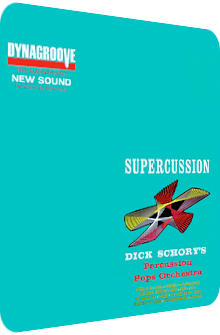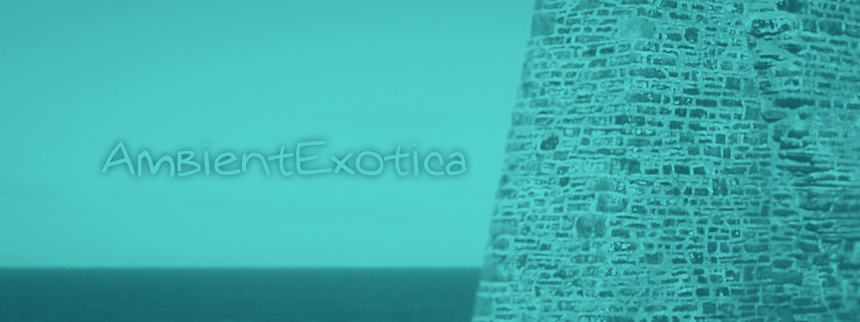
Dick Schory
Supercussion
1963
Yes, I'm being sarcastic here, but a bold, glaringly dazzling and blazingly catchy album title such as Supercussion must be the holy grail for Exotica or Space-Age lovers who favor vividly oscillating percussion aortas in their music, right? That is what the Chicago-based percussionmeister Dick Schory (born 1931) promises with this particular title and all of his other major works that display the prospect of great percussion sequences in their titles. Supercussion is a big budget artifact of 12 tracks which were recorded in 1963 at the Ochestra Hall in Chicago and flacked by producer and percussion expert Marty Gold.
I really do not want to spoil the pleasant anticipation of those readers who do not know this album yet, but I feel the need to at least give a little hint in this review's opening paragraph: the percussion instruments are not the real stars – despite the title – of this album. This status should be dedicated to the prominent inclusion of various mallet instruments such as vibraphones, marimbas and orchestra bells. These are included in each and every of the eleven renditions and the one unique track handed out by Dick Schory himself. No orchestra strings are included, only a few scattered harps and guitars, for Supercussion is a big band album at its core, Schory relies heavily on brass instruments but does not shy away from the inclusion of alto flutes, the latter of which boost the exotic flavor of the album quite a bit. Percussion-wise, the arrangements comprise mostly timpani and other classic drums, but there are bongos and congas on there as well. With an album that is titled Supercussion, these percussion instruments are whimsical. When they are skillfully played though, they can camouflage the lack of variety, can't they? Let's see how things turn out on each of the 12 songs.
I don’t know, but I have always interpreted Billy Strayhorn’s Take The ‘A’ Train as a friendly demand, and why not, the upbeat catchiness of this classic surely suggests such a cordial mandamus. Dick Schory’s Percussion Pops Orchestra does this tune justice, although in an entirely different way, for the tempo is notably sleazy and laid-back, but this perforated, hole-traversed structure allows an interesting interplay between the warmhearted brass blasts, the Crime Jazz-evoking frostiness of the vibes and the thunderous pompousness of the timpani. Even glistening orchestra bells and mellow marimbas made it onto this version, and that’s not all, for the percussion aorta is especially important: the bongos and congas burst in adjacency to the sun-soaked rhythm guitar and the sweeping hi-hats and cymbals. The melody is rather jumpy, different horns and mallet instruments are continuously replaced and adjusted. Take The ‘A’ Train does still feel cohesive and orderly. Though the catchiness of the theme is decidedly perturbed by this stylistic particularity, the bongos are allowed to shine all the more, the reverberation of the vibe and their gelid decay fade away magnificently after every note, the stereo stage is delicately wide whereas the arrangement displays plasticity.
A good kick-off that is followed by a jazzy rendition of Juan Tizol’s, Ervin Drake’s and Hans Lengsfelder’s Perdido. Of particular note are the archetypically wave-like double bass cascades, soothing alto flutes and a technicolor polyphony of a vibraphone coupled with a marimba, the latter of which spirals heavily in front of accentuating silky big band horns. Perdido underwhelms in the end, for it lacks the promised focus on percussion, a problem it shares with Bronislau Kaper’s and Ned Washington’s On Green Dolphin Street, which is still a much greater take thanks to the snugly sunlit warmth and a paradisiac aura. Mesmeric flute tones induce huge amounts of carefreeness, the echoes of the golden-shimmering marimba are almost seducing and the flamboyant twangs of the guitar astonishingly dynamic yet euphonious. The brass section is omnipresent and resides in classic Jazz climes, but I cannot help it, On Green Dolphin Street feels exotic, even more so since it shares many ingredients and places the essential ones in the spotlight.
Milton Davenport’s Nomad is less known in Exotica circles, but that does not prevent Dick Schory’s fast-paced try from being successful. The tension is definitely revved up: what starts distantly Oriental with shawm-like oscillations of a muted trumpet and admixed wondrously diffuse vibraphone tones that lack the usual glitz turns into a bongo- and classic drum-backed Jazz theme with mellifluous flutes and a welcome amount of short percussion solos. Especially the luminescence of the scintillating backing vibraphones is outright spellbinding and a greatly soothing counterpoint to the vivid brass entanglement. In short, Nomad does not necessarily do the album title justice, but its percussive layers are still boldly in place. Johnny Mercer’s eternal Autumn Leaves is next and is undoubtedly the mellowest offering of side A. The glissando of the alto flutes is languorous, the plinking sparkles of the vibraphone are mystifying and the impetus of the brass instruments is fittingly reduced. It may be the most melancholic song of the album, but its downtempo construction offers a nice change of pace. Dick Schory delivers a transfiguring prospect of autumnal nostalgia which consists of manifold exotic slivers.
Closing side A is Harold Weeks’s and Oliver Wallace’s faux-Middle Eastern Hindustan, presented in an eminently dualistic version here. Launching with the stereotyped alto flute tone that display the danger-evoking mystique of a desert town perturbed by sizzling-hot mirages, the cymbal-laden prelude then leads to a big band outing full of fulminant horn eruptions, whirling marimba droplets and their vibraphone foils in higher regions as well as ebbing and flowing double bass accompaniments. The instrumental ends as it began, with a final inclusion of Oriental flute tones.
Jerry Gray's A String Of Pearls opens side B and continues the fusion of exotified big band-oriented Jazz. Dick Schory and his orchestra deliver more of the same brass injections or so it seems, for this arrangement arrangement is actually quite a bit different due to the rather prominent inclusion of a piano which underlines the coruscating brass ensemble quite well. The marimba is once again on board as well, but it does not boost the exotic feeling, for this song is unfortunately rooted in a Saturday night setting due to the evocative horns. Up next is Dick Schory's very own Shimboo which he co-wrote with Bobby Christian. This is another brassy spy concoction, but its short sections are pure gold, either featuring enchanting flutes, twinkling vibes or cool snare drums. Since it is a composition specifically written for this album, it has an exclusive aura, and is even exotic enough to ennoble a bachelor's evening.
Stompin' At The Savoy follows, a Lounge-fueled mélange originally written by the quartet of Andy Razaf, Benny Goodman, Chick Webb and Edgar Sampson, and yes, the first minute evokes that great afternoon feeling that lets one wish for a hammock in order to relax properly. The smashing trumpets and trombones shatter the dreamlike state, and one their reign is overcome, Schory fathoms out the cozier realms again with resplendent vibes and soothing flutes. If those pesky horns were not included, this would have been a gorgeous renditions; the orchestra leader was this close!
The comical-dusky Bijou by Ralph Burns follows, and its signature ingredient is prominently showcased right from the get-go. Great bongos and drums kindle the savage aspects, while a flute-vibe couple enthralls the listener. So far, so great. But there are stylistic flaws that make this tune feel like an imbalanced hodgepodge. While the staccato horns and screeching flutes at the beginning are markers of a comic relief, the second half is loaded with Latinized horns and a hot-blooded atmosphere that clashes horribly with the sparkling tipsiness. And then there's the mentioned cozy middle part. This tune is a labyrinthine mess, I'm sorry to say.
The next song is a treat though, written by trumpeter Mike Simpson who brought us the harpsichord-heavy field recording-focusedSouth African pre-Funk Exotica gem called Jungle Odyssey (1966). His tune The Brush Off turns out to be great in the hands of Dick Schory, for it is again decidedly jazzy. The strong focus on the percussive side of things, however, turns out to be its biggest boon, as is its sunny cheekiness in the form of marimba driblets, paradisiac flutes and staccato horns which are luckily not over the top. The following Krazy Kwilt is the second contribution by Bobby Christian and the final song overall. And it does end things with a bang and many successful particularities, for example its 3/4 time oompa rhythm, a huge dose of thunderous timpani, cascading harp riffs and a positively quirky marimba-flute melody in Yiddish style. A perceptible scent of madness lies in the aural air of this catchy tune. Huzzah!
Supercussion has the same problem many of its brethren have: the bold intertwining of the term Percussion in the title. In this regard, Dick Schory goes the extra mile of showmanship and forms a megalomaniac blending, at least that is the way I perceive it when I compare the title with the presented material. Depending on the good-natured dedication of the listener, one can only count one to three titles that live up to such a boasting title. Sad but true, the percussion is not the primary elemental force, and even if it were, it would be too commonplace and less exotic than I want it to be. Timpani are a poor arranger's bongos, and while they have their raison d'être in the Exotica genre, it is a lackluster effort to overtly rely on them in 1963. And what about other truly exotic percussion devices such as shells, lava stones, bamboo rods or the slightly more conventional claves? Forget 'em, pal!
Again, my criticism is only targeted at the false promise of the title, for the instrumental pool is refreshingly large and Dick Schory does an awful lot of things right. The focus on mallet instruments and convivial flutes turns out to be a splendid choice. Whenever these instruments appear, they balance the brass-heavy performance out and offer an exotic viewpoint through rose-tinted glasses. The sound quality is awesome, Supercussion is one of these albums where the stereo edition is a must. My favorites include On Green Dolphin Street, Take The ‘A’ Train, Autumn Leaves and Krazy Kwilt, but these four could be the tip of the iceberg for those listeners who favor big band arrangements. In this regard, Dick Schory delivers, especially so when he frees his presented material from the kitschy silk. The horns gleam and unleash a great source of heat. Should Exotica fans investigate? Since the album is available in a digital re-issue, I would advise anyone to pre-listen to it. The thing is that all the ingredients and textures that make the Exotica genre so great are on board (minus birdcalls), so there must be people who are much more positively affected by Dick Schory's work. Forget the title, concentrate on the music, and you will likely find some tunes that are worth your while.
Exotica Review 186: Dick Schory – Supercussion (1963). Originally published on Feb. 23, 2013 at AmbientExotica.com.
